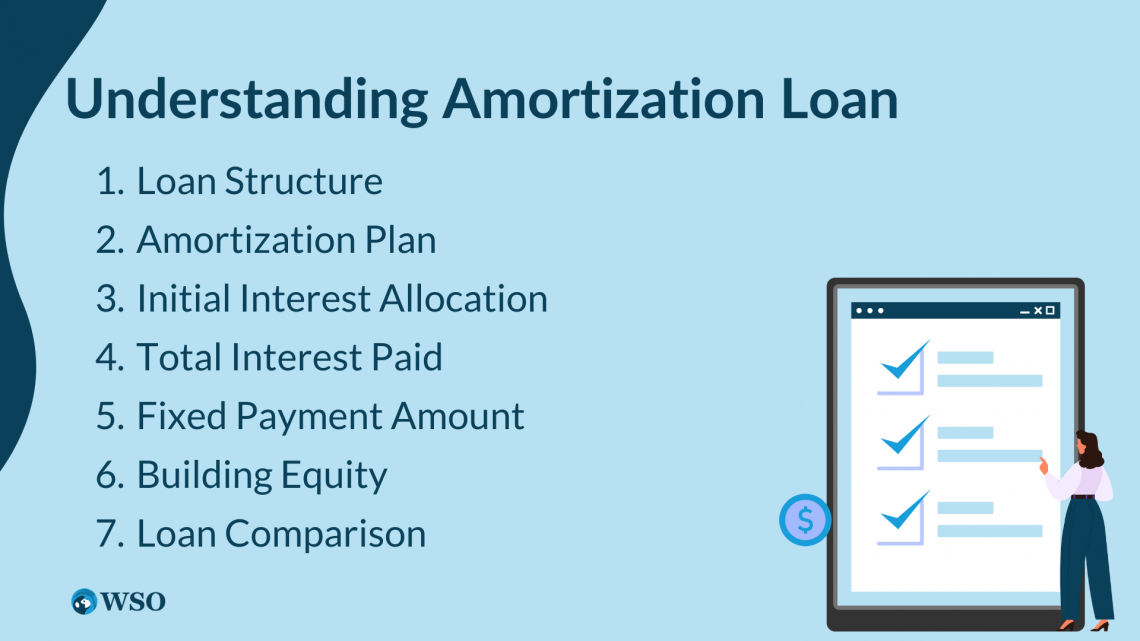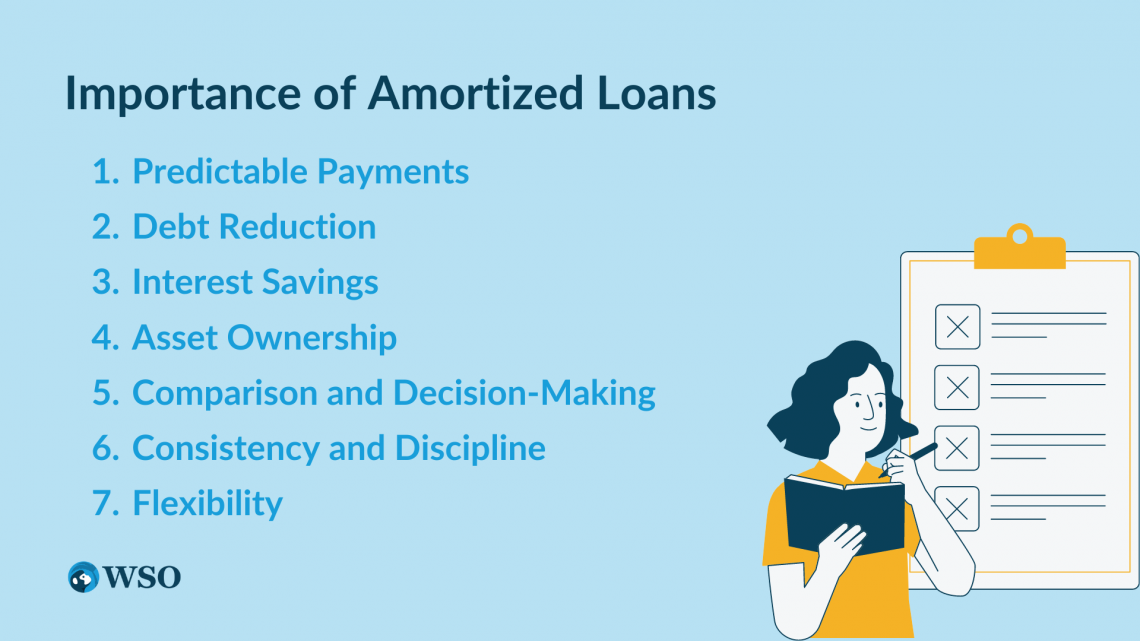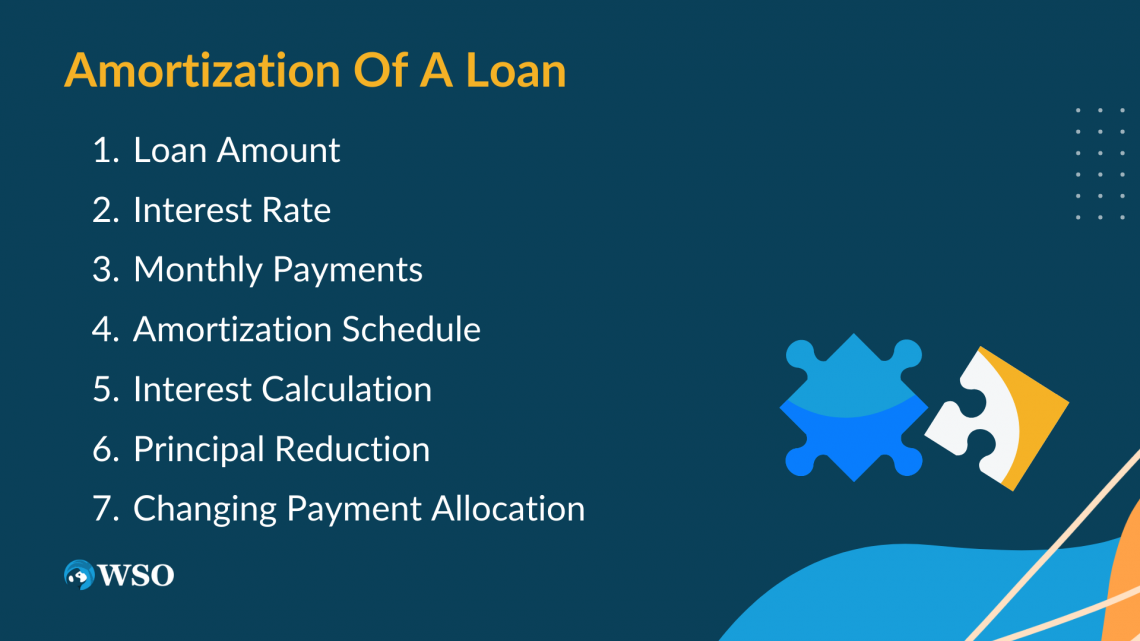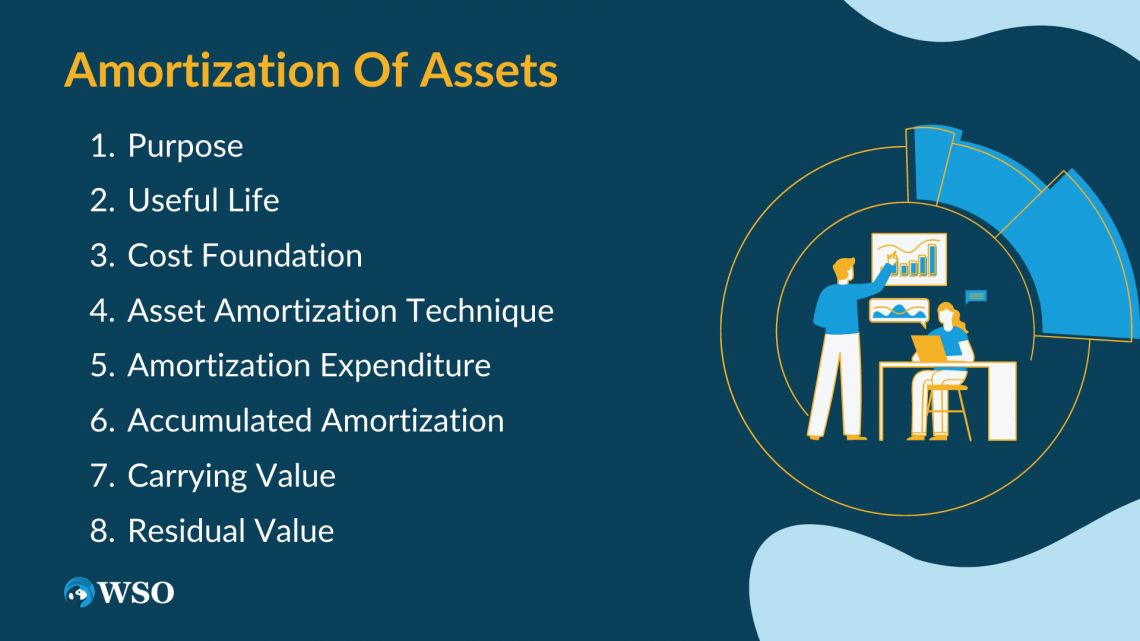Amortized Loan
An amortizing loan is a loan where the principal of the loan is paid down over the life of the loan according to an amortization schedule.
An amortization loan is a mortgage that needs recurrent payments over a certain time to progressively pay off the principal and interest. These payments are often made in equal increments at regular intervals, such as monthly or quarterly, over the loan's tenure.

Amortization refers to spreading out the repayment of a loan over its entire duration, gradually reducing the outstanding debt. Each payment consists of a portion allocated towards interest charges for the given period and the remainder used to decrease the principal.
Even though interest and principal are paid in different amounts during the life of the loan, one important element of an amortized loan is that expenses stay constant.
Amortization spreads out a loan's repayment throughout its life, decreasing the outstanding debt by utilizing a portion of each payment to settle interest payments and reduce the principal.
Although the payment percentage attributed to interest and principal fluctuates over time, the loan payment amount stays constant.
As the principal amount reduces, a greater portion of the payment is devoted to principal reduction rather than interest at the start of the loan.
Note
Compounding periods, rounding, and extra fees or charges can all impact interest and principal amounts.
The amortization plan for a loan is calculated using the loan balance, interest rate, and period. It outlines the payment amount for each period. In addition, it provides a breakdown of how the payment is allocated between the interest and principal, allowing borrowers to see how the loan total would drop over time.
Amortized loans are used for significant purchases such as houses, autos, and personal loans, giving borrowers a predictable repayment plan and allowing them to create equity or reduce debt over time.
Key Takeaways
- Each payment made towards an amortized loan consists of two components: principal reduction and interest payment.
- Initially, a larger portion of the payment goes towards paying off the interest, while a smaller portion is allocated towards reducing the principal. As the loan progresses, this proportion shifts.
- The amortization schedule outlines the specific breakdown of each payment, showing how much goes towards interest and principal.
- Amortized loans offer the advantage of predictable payment amounts, allowing borrowers to plan and budget their finances effectively.
- Amortized loans are commonly used for mortgages, car, and personal loans.
Understanding Amortization Loan
It is essential to grasp the workings of an amortization loan to manage personal debts effectively and make informed financial choices. Here are some key points to consider:

1. Loan Structure
An amortized loan consists of regular payments over a specified period. Each repayment includes principal [the borrowed amount] and interest [the cost of borrowing].
A vehicle loan may have a period of five years, whereas a mortgage might have a duration of thirty years.
2. Amortization Plan
The amortization schedule for the loan specifies the amount of each payment, how principal and interest are divided, and the overall total. It helps you visualize how your payments contribute to reducing your debt.
3. Initial Interest Allocation
Initially, a larger amount of each payment on an amortization loan goes towards interest, while a lesser proportion goes toward the principal.
Note
As the loan progresses, the interest portion decreases, and more of each payment is applied to the principal.
4. Total Interest Paid
Since the interest is calculated based on the remaining balance, the total interest paid decreases over time as you make regular payments and reduce the principal.
5. Fixed Payment Amount
The monthly payment for a loan remains the same throughout the term. However, the allocation between interest and principal changes, as mentioned earlier. This fixed payment allows borrowers to plan their budgets and ensure consistent repayment.
6. Building Equity
Amortized loans, like mortgages, allow borrowers to gradually increase their ownership stake in an asset (such as a property).
As the principal is paid down, the ownership stake in the asset increases. This equity can be valuable for future financial planning or borrowing against the asset.
7. Loan Comparison
Understanding the amortization structure can help you compare different loan offers. When agreeing to an amortization loan, carefully research all the details, particularly lending rates, costs, and repayments.
Utilizing a mortgage calculator or consulting financial advisers can help you completely comprehend the implications of your mortgage decisions and how they relate to your financial targets.
Importance of Amortized Loans
Amortized loans are important for several reasons:

1. Predictable Payments
Amortized loans provide borrowers with predictable payment amounts throughout the loan term. In addition, the fixed payment amount helps avoid surprises or fluctuations in your repayment obligations.
2. Debt Reduction
Each amortized loan payment applies a portion to the principal balance, reducing your debt over time.
This gradual reduction allows you to build equity in an asset (such as a home) or decrease your debt burden. In addition, it gives you a clear path toward becoming debt-free.
3. Interest Savings
The amortization structure of the loan ensures that interest is paid off gradually over the term. As the principal balance decreases, less interest is charged on the remaining balance.
Interest savings refers to the decrease in interest paid on credit cards or loan balances, which lowers total expenditures.
This can be accomplished via several techniques, including
- Refinancing at a reduced interest rate
- Making additional principal payments to reduce the loan's duration
- Taking advantage of promotional offers with low or zero-interest rates
Note
Compared to loans with higher inflation or involvement loans, you have to pay less interest over time, potentially resulting in long-term savings.
People may gradually save money and pay off their debts more rapidly by actively looking for advantageous interest rates and responsible debt management. These interest savings may greatly influence personal finances and help maintain financial stability in the long run.
4. Asset Ownership
Amortized loans, particularly for major purchases like homes or cars, allow you to build equity and eventually own the asset outright gradually.
As you make regular payments and reduce the principal, your ownership stake in the asset increases. This can provide financial stability and a valuable asset for the future.
5. Comparison and Decision-Making
The structure of an amortized loan makes it easier to compare different loan offers. This empowers borrowers to make informed decisions and choose the loan that best aligns with their financial goals and objectives.
6. Consistency and Discipline
Amortized loans require regular payments, which can foster financial discipline and accountability.
Sticking to a consistent payment schedule establishes a habit of managing your debt responsibly. Over time, this can help you become more creditworthy and financially secure.
7. Flexibility
While the payment amounts are fixed, most amortized loans allow for prepayments or early repayment without penalties. This flexibility allows borrowers to pay off their debt sooner with extra funds available.

Amortization loans provide a structured and manageable approach to borrowing, enabling borrowers to plan their finances, reduce debt, build equity, and progress toward their financial objectives.
Amortization of a loan
This reduces the loan balance until it is fully repaid. Here is a detailed explanation of the loan amortization process:

1. Loan Amount
This represents the whole amount borrowed and is referred to as the initial loan amount.
2. Interest Rate
The lending contract specifies the interest rate, computed by the lender as a percentage of the loan amount as compensation for lending you the money. The interest rate influences the borrowing expenses over the loan's life.
3. Monthly Payments
Each monthly payment is made up of two parts: interest and principal.
4. Amortization Schedule
An amortization schedule is a table or spreadsheet that summarizes each payment throughout the life of the loan. It breaks out the payment amount, interest part, principal portion, and remaining loan balance.
5. Interest Calculation
As the main debt decreases over time, the interest component of each payment also reduces.
6. Principal Reduction
The principal reduction portion of each payment helps gradually pay off the borrowed amount over the loan term.
7. Changing Payment Allocation
The proportion of the installment assigned to interest and principal changes with each payment. Initially, a greater amount is allocated to interest, and a greater portion is applied to principle as the loan develops.
Borrowers may comprehend how their payments contribute to decreasing the principal balance and follow their progress in repaying the loan by understanding loan amortization.
Amortization of assets
Amortization refers to systematically allocating an asset's cost over its useful life. It is an accounting approach for matching the cost of acquiring or manufacturing an asset with the income or benefits provided by that asset during its lifetime.

Here are the main factors to remember regarding asset amortization:
1. Purpose
The purpose of amortizing an asset is to record its cost as an expense throughout its useful life, representing the consumption or expiration of its value. This technique is consistent with the matching concept in accounting, which seeks to match costs with revenues.
2. Useful Life
Each asset has an estimated useful life, which defines the period over which it is projected to contribute to revenue generation or provide advantages to the firm.
Wear and tear, technical obsolescence, and legal or contractual constraints all play a role in determining useful life.
3. Cost Foundation
The initial basis for amortization is the asset's cost, including the purchase price, acquisition charges, transportation, installation, and other necessary expenses. It denotes the entire cost spent on acquiring or manufacturing the item.
4. Asset Amortization Technique
The straight-line method is the most often utilized method of asset amortization. The asset's cost is distributed equally across its useful life under this strategy, resulting in a constant yearly expense.
Note
Other techniques, such as accelerated procedures, may be utilized for certain types of assets or by tax legislation.
5. Amortization Expenditure
It is a portion of the cost of an asset reported as an expenditure each accounting period. Therefore, it is shown on the income statement and reduces the period's reported net income.
6. Accumulated Amortization
As amortization expenditure is recorded for each period, it is accumulated in a separate contra-asset account known as accumulated amortization.
This account reduces an asset's balance sheet carrying value by representing the percentage of its cost expensed over time.
7. Carrying Value
An asset's carrying value is its initial cost less accrued amortization. It represents the net worth of a balance-sheet asset at any point in time.
8. Residual Value
The residual value of an asset is its predicted value at the end of its useful life.
Amortization of assets assists firms in correctly reporting their costs and matching them to the income or benefits generated by the assets. It also gives a method for accounting for the steady depletion or expiry of an asset's value over time.
Amortized Loan Vs. Balloons Loan Vs. Revolving Debt
Before we compare amortized loans, balloon loans, and revolving debt, it is critical to understand these debt instruments' underlying distinctions. Each financing choice has distinct characteristics, repayment schedules, and borrower ramifications.

By evaluating their qualities, borrowers may select which sort of debt best fits their financial requirements and aspirations. But first, let's look at the essential features and contrasts between these three types of debt.
Amortized Loan
- Regular payments: Amortized loans need monthly payments, normally given in equal increments over a certain length of time.
- Principal and interest: Each payment contains a component applied to the principal debt and another portion to the interest on the outstanding balance.
- Fixed payment amount: Borrowers benefit from predictability because the payment amount remains constant throughout the loan period.
- Gradual principal reduction: A percentage of each payment is applied to the principal balance, resulting in a steady reduction in the outstanding loan amount.
Balloon Loan
- Large final payment: A balloon loan requires smaller monthly payments during the loan term, with a bigger "balloon" payment due at the conclusion.
- Partial amortization: The periodic payments often cover only the interest or a portion of the principal and interest, resulting in a principal amount left at the end of the loan term.
- The balloon payment: At the end of the loan period, a payment bigger than the monthly installments is necessary to pay the outstanding principal balance fully.
- Shorter loan term: Balloon loans often have shorter periods, ranging from a few months to a few years.
Revolving Debt
- Ongoing credit line: Revolving debt is a sort of credit agreement in which the borrower has access to a predetermined credit limit that can be borrowed, repaid, and borrowed again.
- Flexible payments: Borrowers can make variable payments dependent on the outstanding debt, and there is no set payment amount or timetable.
- Revolving credit: The available credit replenishes when the borrower repays the amount, allowing for continued borrowing and repayment.
- Interest charges: Interest is only levied on the amount borrowed and for the due time.
- No fixed repayment term: Revolving debt has no defined payback period as long as the borrower makes timely payments and keeps the account in good standing.
Conclusion
In summary, an amortized loan requires monthly equal installment payments to progressively pay off the loan debt. In contrast, a balloon loan requires smaller periodic payments with a greater final payment required at the end.

On the other hand, Revolving debt provides continuous access to a credit line with variable payments and no set payback period. Each type of debt has advantages and considerations, and borrowers should choose based on their specific financial needs and goals.
An amortized loan is a form of loan that requires regular payments over a certain length of time to repay both the principal and the interest progressively. The loan installments are structured to be consistent throughout the loan period, with each payment paying a portion of the principal and interest.
Amortization involves dividing the total loan amount into equal installments, usually paid monthly, although other intervals can also be used.
During the first few months of the loan term, a higher amount of the installment is dedicated to interest payments, with a lesser portion dedicated to principal repayment.

As the loan progresses, the loan amount decreases, resulting in a continuous trend toward paying a larger percentage of the payment to the principal, decreasing the overall interest charged.
Amortized loans give borrowers a precise payback schedule, allowing them to properly budget and organize their resources. They also make it easier to control the cost of borrowing by spreading out payments over time.
While the monthly payments of a loan are constant, the composition changes with time. This amortization procedure ensures that the loan is paid in full by the end of the agreed-upon period, allowing borrowers to own the item or property they funded.




or Want to Sign up with your social account?